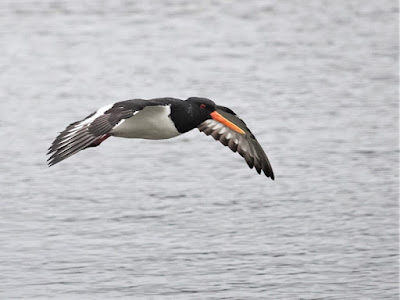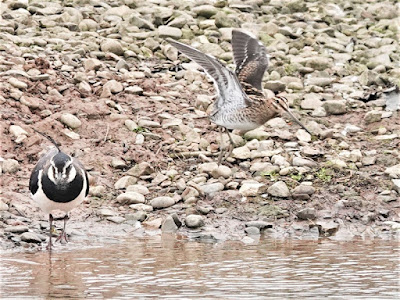Today I paid a visit to
Parkgate on the Wirral side of the Dee Estuary for the high Spring tide. On the very highest tides the whole of the salt-marsh gets inundated. Only a few areas of floating vegetation remain. Otherwise the river covers the area between the Parkgate sea wall and Wales, several miles away on the opposite bank.
Mammals that live in the salt-marsh are forced to flee for their lives ahead of the rising water. I believe it to be a Bank Vole.
Another clinging to what vegetation it can find.
This one got a very wet body before it managed to climb out of the water.
Also fleeing the rising tide is what might be White-toothed Shrew. If the teeth are red-tipped then it is a Pygmy Shrew. I didn't look.
This is part of a Mole which had found a ledge on which to dry out.
Hunting the fleeing mammals are birds of prey. Here a male Kestrel is on the look-out.
Compare the plumage with this hovering female Kestrel.
There was much dispute among the gathered throng of birdwatchers as to whether this was a Sparrowhawk or a Kestrel. Certainly the wing-tips do not look pointed as they appear on most views of falcons. However the markings identify it as a female Kestrel which was not the consensus at the time.
A slightly different view.
A female Marsh Harrier on the hunt. The white on the crown and patchy-looking wings identify. There were fewer harriers around than on many visits I have made. There was, unusually, a female Hen Harrier (sadly no photo).
Carrion Crows are always on the look out for a meal.
For contrast a Raven showing its massive bill.
As the last of the salt-marsh was disappearing these Black-headed Gulls were also on the look-out for a meal.
One snatches what is probably a vole.
Another, bottom left, has also been victorious. It will need to fend off a Carrion Crow and an immature Lesser Black-backed Gull as well as all the other Black-headed Gulls.
Three Great White Egrets, identified by size and their yellow bill. On the left a Little Egret. It does not look 'white' here as it is standing amongst brown grass stems.
Great Egrets are large. Little Egrets would show obvious yellow feet, unless they have been feeding in gooey mud.
From October to March the estuary is a feeding ground for Pink-footed Geese. Here are three. These are a smaller species than the familiar Canada and Greylag Geese with small dark bills variably marked with orange.
Parties of Pink-footed Geese tend to fly in rather ragged formations.
The air can get crowded.
Did I sat crowded? As the ride rushed in all the Pink-footed Geese feeding on the salt-marsh took to the air together in whirr of wings.
Not my best photo of a passing Curlew. I included it as it shows the rarely-noticed patterning on the outer part of the under wing.
There is a lot going on here. Most of the birds are Redshank. On the water to the right are two Canada Geese and one Greylag Goose. On the left of the water are two Pink-footed Geese. The small duck on the far left is a duck Common Teal. The most bizarre is the goose taking off which is one of two Bar-headed Geese that suddenly appeared and then almost equally suddenly disappeared. This species of goose resides in Central Asia migrating over the Himalayas to winter in the Indian sub-continent. Birds seen in the UK are all releases or escapes from wildfowl collections.
A closer view of the Redshank flock. Careful observation shows the left-hand of the two birds top-centre is different (as is the right-most bird of the group). They are Ruff in winter plumage and hence without any 'ruff', neck feathers acquired by males in the breeding season, which gives the species its name. Redshank appear dark...
...and light as their underside shows as they fly the other way.
This view of a first winter Herring Gull clearly shows how strongly marked the area is above the tail band, both on the upper-tail and the lower part of the back. A similar-aged Lesser Black-backed Gull would show a well-delineated black tail band and almost unmarked upper tail giving it a far neater appearance.
It has obviously caught some unfortunate mammal and the Black-headed Gulls are looking to steal it.
This was odd. A group of eleven Skylarks are seen here apparently feeding on one of the small floating islands of vegetation. They would typically feed on seeds at this time of year. Why would seeds accumulate on the vegetation?
(Ed Wilson)












































































